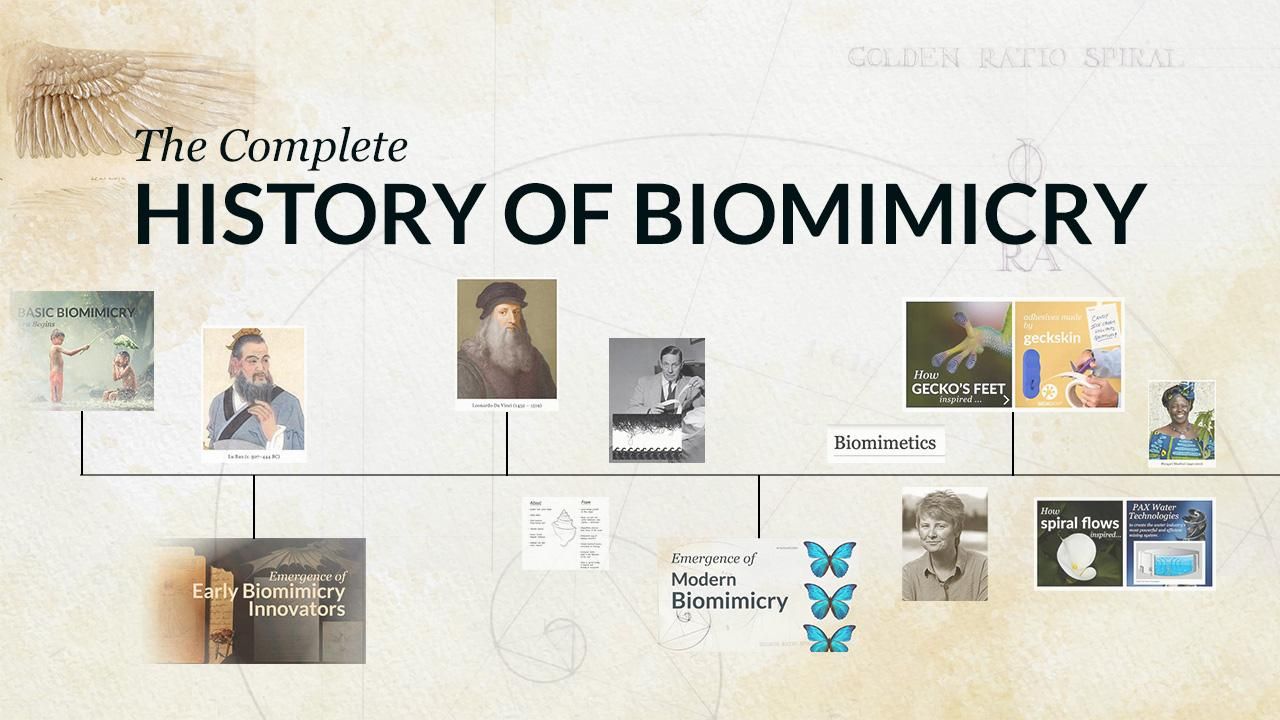The Complete History of Biomimicry (with Examples)

If Imitation is the sincerest flattery, humans have been applauding the natural world for a good while now, perhaps since its inception. Emulating nature for designs that work is not new, and biomimicry (or biomimetics) is a (re)emerging discipline of ancient practice found within the majority of indigenous cultures. Then we forgot. We seemed to have lost this innate practice after the agricultural, industrial and scientific revolutions. What happened, and how did it come that biomimicry would re-emerge once again?
Biomimicry Across Ages: From Inventor Sparks to a Bonfire Movement
History reveals the sparks of biomimicry, lit briefly by the individual inventors Da Vinci, Frank Lloyd Wright, Frei Otto, and Buckminster Fuller. Each inventor clearly looked to nature. Each inventor was considered a genius of their time.
“These isolated instances are great examples, but are not considered the start of a larger emergence. There was no body of work, no scholarship, no cohorts of students trained to be nature’s proteges. And so biomimicry went dormant again.” - Janine Benyus
Ah, Janine. The biomimicry angel who re-ignited it all. The isolated inventors did informally practice and apply biomimicry, but it was only when Janine published her book: Biomimicry: Innovation Inspired by Nature, did biomimicry bloom like wildflowers in the spring across a wide range of science disciplines. In the end, words are one of the few things which last, and her book is a masterpiece. Formal or Modern Biomimicry thus (re)emerged as a discipline of ancient practice in 1997.
What is the history of biomimicry (with examples)?
The timeline of biomimicry: An overview of key developments in the history of biomimicry.
General Landmarks of the History of Biomimicry
- Basic Biomimicry Era: The Early Observations and Inspiration (Pre-15th Century)
- Emergence of Early Biomimicry Innovators (15th - 20th Century)
- Emergence of Modern Biomimicry (Late 20th Century)
- The Cambrian Explosion of Biomimicry and Research (21st Century to present day)
Specific (and Historic) Biomimicry Examples
- Lu Ban (c. 507-444 BCE) - Renowned carpenter, credited with inventing the umbrella, inspired by a giant lily leaf; and the saw, inspired by a serrated vine stem.
- Leonardo Da Vinci (1452 - 1519) - A prolific cross-disciplinary inventor who derived inspiration from the close observation of nature.
- 1941: Velcro is Invented - In 1941, While taking a walk through the woods, Swiss electrical engineer, George de Mestral, discovered the cocklebur is comprised of hundreds of tiny hooks that cling tenaciously to fabrics and animal fur. This inspired the hook and loop fasteners
- R. Buckminster Fuller (1895-1983) - Designer, educator and Systems Thinking pioneer whose designs were both resource-efficient and widely beneficial.
- 1950s - 'biomimetics' term appears - In the 20th century, Otto Schmitt established biomedical engineering and coined the term “biomimetics” as he invented the Schmitt trigger, inspired by the squids’ nervous system.
- 1958 - Field of Bionics Emerges - Coined by Jack E. Steele at the Aeronautics Division House at Wright-Patterson Air Force Base in Dayton.
- Janine Benyus is born (1958 - Present) - Biologist, author, innovation consultant, and self-proclaimed “nature nerd.” She may not have coined the term biomimicry, but she certainly popularized it in her 1997 book Biomimicry: Innovation Inspired by Nature.
- Michael Pawlyn (1967 - Present) - Michael Pawlyn is an architect and has a well-earned reputation as a pioneer of biomimicry.
- Claire Janisch (1975 - 2022) - A chemical engineer by training, Claire charted a path for biomimicry most notably in South Africa, but her impact was undoubtedly global. Claire founded BiomimicrySA, Syntropy and Learn Biomimicry. She was instrumental in helping to establish the practice of biomimicry across the world through advocating, practice and education.
- 1982: The Term Biomimicry appears in scientific literature, in a chemistry thesis written by Connie Lange Merrill.
- 1996: The Eastgate Centre opens in Harare, Zimbabwe. At the time, the country’s largest office and shopping complex was an architectural marvel in its use of biomimicry principles.
- 1996: Pax Lily Impeller Invented - Jay Harman and the scientists at Pax Water develop active tank mixing technology and other applications like fans which have reduced the energy required for similar outputs by about 30%.
- 1997: Janine Benyus publishes her book Biomimicry: Innovation Inspired by Nature
- 1997: Biomimicry & the Bullet Train - The Shinkansen bullet train gets redesigned by the lead designer and an avid bird watcher Eiji Nakatsu
- 1998: Dayna arrives on the biomimicry scene. A pioneering biomimicry thought leader, business consultant, and professor, Dayna has been instrumental in the creation of modern biomimicry, the “formalised” education and application of biomimicry. She designed the world’s first Biomimicry Professional Certification Program, a two-year master-level course in biomimicry. As senior editor, Dayna compiled a decade of experience in biomimicry into a practical how-to guide Biomimicry Resource Handbook: A Seed Bank of Best Practices (2013). Additionally, Dayna has practically applied biomimicry and consulted to over 100+ businesses, including Interface, Nike and Boeing.
- 1998: Biomimicry 3.8 is founded by Dayna Baumeister and Janine Benyus
- 1999: InterfaceFLOR gathered for their first biomimicry workshop. You can read the full biomimicry case study here
- 2006: The Biomimicry Institute is founded. Founded as a not-for-profit organisation in the United States, the Biomimicry Institute's goal is to help innovators learn from nature in order to design sustainable products, processes, and policies in response to real-world problems.
- 2007: Ask Nature is Created: Ask Nature is a collection of biological strategies and nature-inspired innovations. Today it is the most widely used biomimicry resource and is a portal to the wisdom nature holds. AskNature is a project of the Biomimicry Institute
- 2008: 98% of all Olympic Golds are Won Using a Nature Inspired Innovation - inspired by the denticles of a shark (aka skark skin).
- 2010: Slime Mold Inspires Tokyo City Planners
- 2010: The launch of the first cohort of Biomimicry Professionals (B.Pro’s)
- 2011: First demonstration of the SLIPS technology: SLIPS is a porous network of Teflon nanofibers that are infused, like a sponge, with an oil- and water-repelling fluid, that mimics the pitcher plant but also improves on it by repelling fluids of all types. The SLIPS technology has spawned a new company – Adaptive Surface Technologies.
- 2011: Biomimicry in Architecture book is published
- 2012: Geckskin is Invented: a team of researchers at the University of Massachusetts- Amherst, led by Al Crosby and Duncan J. Irschick, unveiled a new super adhesive called Geckskin, modelled after the ability of geckos to stick to almost any surface.
- 2013: The Shark's Paintbrush: Biomimicry and How Nature is Inspiring Innovation is published
- 2013: CEEBIOS is founded in France
- 2015: Biomimicry Global and Biomimicry Youth Design Challenges Emerge
- 2017: The Ray of Hope Prize Launches
- 2020: Learn Biomimicry is Founded ; )
Are you interested in learning more about biomimicry? Start where you are, no experience needed. Get a solid understanding of what biomimicry is and how it can be applied through in-depth videos and handbooks. Promote your career, upskill yourself and get a certificate endorsed by the Biomimicry Institute through the Biomimicry Foundational Short Course Set.
What is the first example of biomimicry?
The flying machines of Leonardo Da Vinci are the earliest biomimicry example. He very closely observed the anatomy and flight of birds and made numerous notes and detailed sketches of his observations. These sketches of proposed "flying machines"... known today as an airplane.
His research later inspired the Wright brothers. These two American aviation pioneers would go on to invent, build, and fly the world's first successful motor-operated airplane. Though Leonardo never built this biomimicry invention, his drawings stand as a simple but profound example of biomimicry!

Ah, Leo. Simply a man ahead of his time. Leonardo's inventions and drawings stand as the earliest examples of modern biomimicry, but what about ancient biomimicry?
The Look at Informal Biomimicry: An Ancient Practice of Emulating Nature
Indigenous wisdom in action: The first Chinese umbrellas were invented 1700 years ago by a man named Lu Ban, who is now revered in Chinese history. The idea for the umbrella sprouted when Lu Ban saw children using lotus leaves to shield themselves from the rain. He decided to mimic the flexibility and effectiveness of the leaf and create a product of his own. The first umbrellas were, in fact, made of silk.

A fun-loving scene which we can imagine inspired Lu Ban
How did it come that biomimicry would re-emerge once again?
- Sustainability Pressures: Biomimicry is emerging again as a discipline because of the combination of the sustainability pressures on us and the enabling technologies that allow us to study and copy nature better than ever before.
- The work of the Biomimicry Institute, Biomimicry 3.8 and other key biomimicry organisations to educate and enable the practice of biomimicry has been significant in its evolution as a discipline. They are the leaders in developing practical tools and methodologies in the practice of biomimicry. They have also been actively involved in seeding a global biomimicry network of practitioners and educators in the field of biomimicry.*
- The formalizing of biomimicry as a profession: In addition, there are now many academic and other researchers involved in biomimicry. We now even find the emergence of very specific biomimicry research departments in academic institutions and biomimicry is now also a formal profession.
How can biomimicry help us in the future?
‘At its most practical, biomimicry is a way of seeking sustainable solutions by borrowing life’s blueprints, chemical recipes, and ecosystem strategies. At its most transformative, it brings us into right relation with the rest of the natural world, as students learning to be a welcome species on this planet’ - Janine Benyus
Frequently Asked Questions / FAQS
Has biomimicry ever been called something else? Had a different name?
Yes, biomimicry is sometimes referred to as biomimetics (coined in the 1950s), bionics and bio-engineering. Though all these fields overlap, each holds different goals and approaches. Biomimicry is explicitly about nature-inspired innovation with the end goal of creating conditions conducive to life (read: sustainability).
Biomimicry is an ancient practice found within the majority of indigenous cultures, but there was no specific name that we are aware of.
Why did biomimicry not become a discipline sooner?
Since the 1950s, research suggests, we have become more and more distanced from nature and its life-giving benefits. The term “biomimicry” only entered the innovation lexicon in the 1990s, and if I may speculate, its popularity has grown due to the recent ecological and climate crises humanity faces. Only recently, speaking in ecological terms, did humans disconnect (or at least distance themselves) from nature.
Additionally, it is only recently humanity has exponentially increased its scientific understanding of biology and created enabling technologies that dramatically improve our ability to make designs and products that function like nature.
How have the methods of biomimicry changed over time?
Biomimicry is very much in its infancy. Imagine a new practice like science or meditation. Both of which have a 5000-year head start. Additionally, biomimicry requires science and enables technologies to be applied. It’s changing rapidly as early adopters lead the way.
Interested in design approaches? Explore the article: What is Life-Centered Design?
Closing thoughts
Biomimicry has evolved beyond an academic exercise. It has become an innovation in itself. The practice of biomimicry allows individuals and companies to develop a new class of products and services that are both innovative and sustainable.
Today, biomimicry has emerged as a formal profession, with interdisciplinary organizations, journals, conferences and even training for biomimicry as a profession.
Biomimicry is an evolving field that continues to grow as our understanding of nature deepens and as technology advances. It demonstrates how nature's solutions can inspire innovative and sustainable solutions to human problems.
The future looks inspiring and bright. The next question we now ask is: What would nature do?
Wild regards
Alistair Daynes, Biomimicry Practitioner
Interested in more reading? Explore the article: Top10 Biotech Companies Practicing Biomimicry
PS: If you'd like to dive into the world of biomimicry, you can download our app to get a FREE micro-course, or explore our Short Course Set. Learn biomimicry wherever you are!

